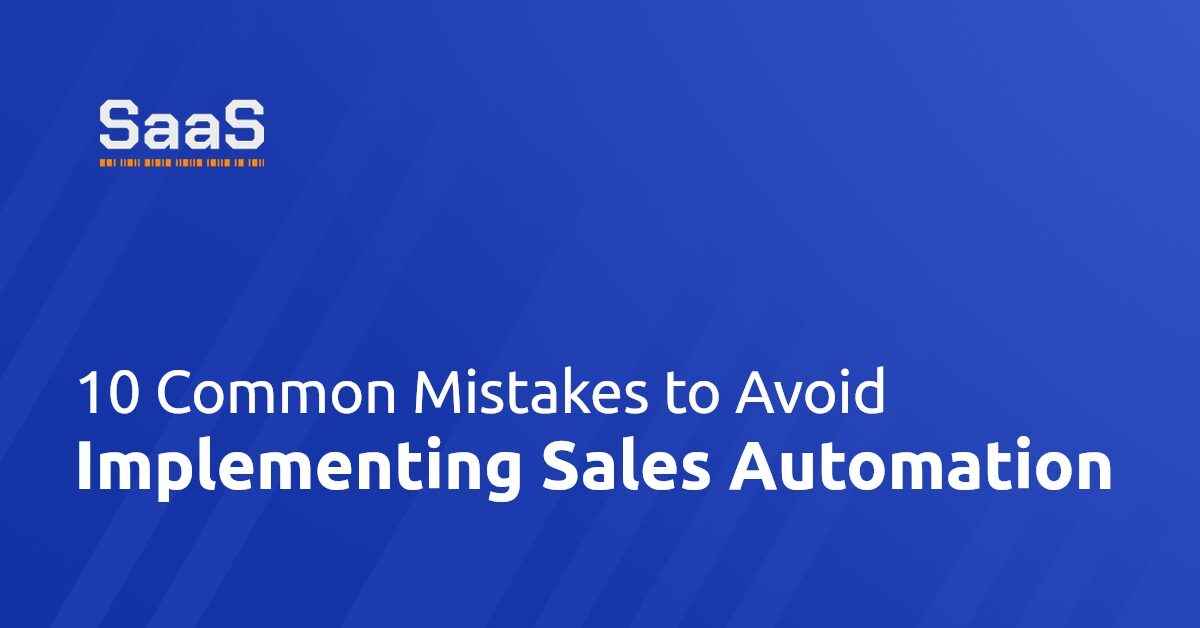In today’s rapidly evolving business landscape, sales automation has emerged as a powerful tool for enhancing operational efficiency and optimizing sales processes. Implementing sales automation can lead to increased productivity, improved customer engagement, and ultimately, higher revenue. However, like any transformative initiative, successful implementation requires meticulous planning and execution to sidestep common pitfalls. In this article, we’ll explore the ten prevalent mistakes to steer clear of when incorporating sales automation into your business strategy.
Mistake 1: Lack of Clear Strategy
One of the most prominent blunders companies make is embarking on sales automation without a well-defined strategy. It’s imperative to set clear objectives, map out existing sales workflows, and identify potential areas that stand to benefit from automation. By aligning automation efforts with specific sales goals, you can ensure a focused and successful implementation.
Mistake 2: Neglecting Data Quality
The accuracy and timeliness of data are crucial for effective sales automation. Overlooking data quality can lead to erroneous insights, squandered resources, and compromised decision-making. Before initiating automation, invest time in refining and organizing your data to provide a robust foundation for your automation endeavors.
Mistake 3: Underestimating User Training
The efficacy of even the most advanced automation tools hinges on the competence of the users. Failing to provide adequate training to your sales team on the operation of new tools and processes can result in frustration, resistance, and diminished productivity. Prioritize comprehensive training programs to empower your team and extract the maximum value from sales automation.
Mistake 4: Overlooking User Experience
A seamless user experience should be a paramount consideration during the implementation of sales automation. If new tools prove to be complex and challenging to navigate, your sales team might be hesitant to adopt them, leading to subpar utilization and diminished efficiency. Emphasize user-friendly interfaces and intuitive processes to foster a positive user experience.
Mistake 5: Automating Inefficient Processes
Automating ineffective processes merely amplifies inefficiency. It’s prudent to assess and optimize your current sales processes before introducing automation. Reimagine workflows to eliminate redundancies and bottlenecks. The objective of automation should be to enhance efficiency rather than perpetuate shortcomings.
Mistake 6: Disregarding Customization
Off-the-shelf automation solutions might not seamlessly align with your unique sales processes. A prevalent misstep is to implement generic automation tools without customization to cater to your specific needs. Tailor your automation solutions to harmonize with your organization’s workflows and prerequisites for optimal outcomes.
Mistake 7: Neglecting the Human Touch
While automation can significantly elevate efficiency, it’s essential to strike a balance between automation and human interaction in sales. Over-automation can lead to impersonal experiences and reduced customer satisfaction. Utilize automation to manage repetitive tasks, but ensure there’s ample room for authentic human interactions that cultivate meaningful client relationships.
Mistake 8: Skimping on Integration
Sales automation should seamlessly integrate with your existing systems, such as CRM, marketing, and customer support platforms. Failure to achieve this integration can result in data silos and hinder the fluid exchange of information across different departments.
Mistake 9: Ignoring Monitoring and Adaptation
The implementation of sales automation is an ongoing process rather than a one-time event. Organizations often commit the mistake of setting up automation and subsequently neglecting its performance. Regularly monitor key performance indicators (KPIs) and solicit feedback from your sales team to identify areas for enhancement and make necessary adjustments.
Mistake 10: Underestimating Change Management
Introducing sales automation constitutes a significant change for your sales team. Neglecting to manage this change effectively can lead to resistance, confusion, and even project failure. Articulate the benefits of automation clearly, involve your team in the decision-making process, and extend continuous support as they adapt to new tools and methodologies.
In conclusion, sales automation possesses immense potential for optimizing sales productivity and catalyzing business expansion. However, to harness these advantages fully, organizations must sidestep common pitfalls. By formulating a well-defined strategy, prioritizing data quality, focusing on user experience, and integrating automation thoughtfully, you can ensure a successful implementation. Always bear in mind that sales automation transcends technology—it’s about harmonizing people, processes, and technology to realize your sales goals more efficiently and effectively.







